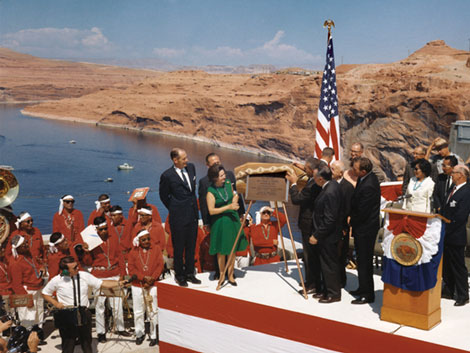

Arizona celebrates Representative John Rhodes' victory in pushing the CAP authorization through Congress. Construction begins on the Navajo Generating Plant, but environmentalists are making their voices heard. Reclamation Commissioner Floyd Dominy takes a legendary raft trip down the Colorado River with David Brower of the Sierra Club. The Endangered Species Act and National Environmental Protection Act are passed in 1969. The transition begins in Arizona from agricultural to municipal water use.
Legislation
The 1960s did not mark the end of activities associated with Arizona v. California. In 1979, the Supreme Court issued a Supplemental Decree which addressed present perfected rights referred to in the Colorado River Compact and in the Boulder Canyon Project Act. These rights are entitlements essentially established under state law, and have priority over later contract entitlements. On March 27, 2006, the Supreme Court issued a ... more
 First Lady, Mrs. Lyndon B. Johnson, dedicates Glen Canyon Dam – 1966. Reclamation photo.
First Lady, Mrs. Lyndon B. Johnson, dedicates Glen Canyon Dam – 1966. Reclamation photo.(Adapted and excerpted from 2006 Bureau of Reclamation report on the Glen Canyon Unit of the Colorado River Storage Project by Jedediah Rogers.)
The rich and controversial social and political history of Glen Canyon Dam began with the Colorado River Storage Project Act of 1956. CRSP authorized construction of the Glen Canyon Dam as one of four major storage reservoirs along the Colorado River and its tributaries. Few, if any, large-scale reclamation projects have generated as much controversy and emotion as Glen Canyon Dam and its reservoir, Lake Powell.
The site of the dam, 15 miles north of Lee's Ferry, Arizona, is a narrow gorge cut by the Colorado River, its canyon walls and foundation made of sandstone and shale.
Prior to the filling the reservoir, on canyon walls and river bottoms, there were poignant reminders of a rich history, left behind by ancient Indians, Spanish explorers, Mormon pioneers, and enterprising businessmen. Reclamation officials did what they could to help record the history before it was lost. But salvaging the history of the canyon before the dam went up was secondary to the primary concern at hand: building a dam, a storage reservoir, and a hydroelectric plant.
Congress authorized Glen Canyon dam on April 11, 1956, with passage of the Colorado River Storage Act. The Glen Canyon Project was never ... More
